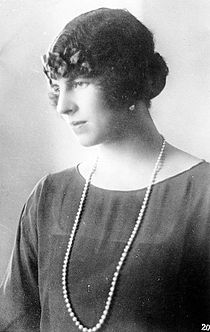Helena af Grækenland
| Helena af Grækenland | |
|---|---|
 Dronning Helena | |
| Dronningemoder af Rumænien | |
| Ægtefælle | Carol 2. af Rumænien (g. 1921; sk. 1928) |
| Børn | |
| Hus | Huset Glücksborg |
| Far | Kong Konstantin 1. af Grækenland |
| Mor | Prinsesse Sophia af Preussen |
| Født | 2. maj 1896 Athen, Kongeriget Grækenland |
| Død | 28. november 1982 (86 år) Lausanne, Schweiz |
| Religion | Græsk-ortodoks |
Prinsesse Helena af Grækenland og Danmark (græsk: Πριγκίπισσα Ελένη της Ελλάδας και Δανίας; 2. maj 1896 – 28. november 1982) var en græsk prinsesse, der var hustru til kong Carol 2. af Rumænien og mor til kong Mihai 1..
Biografi
Tidlige liv
Prinsesse Helena blev født den 2. maj 1896 i Grækenlands hovedstad Athen, datter af kronprins Konstantin. Hun havde tre brødre — Georg, Alexander, og Paul — som alle tre blev konger af Grækenland, og to søstre, Irene og Katharina. På grund af politiske uroligheder i Grækenland måtte Helena og hendes forældre gå i eksil flere gange. Hun mødte kronprins Carol af Rumænien i Schweitz i 1919. De blev gift i 1921. (Hendes bror Georg giftede sig med Carols søster Prinsesse Elisabeth.)
Kronprinsesse og dronningmor
Deres søn og eneste barn Mihai blev født i 1921. Ægteskabet var dog ikke lykkeligt, da Carol i 1925 begyndte en kærlighedsaffaire med Magda Lupescu. På grund af skandalen måtte han opgive sin stilling og gå i eksil. Mihai blev kronprins og Helena blev tildelt titlen "Princesse af Rumænien".
Da kong Ferdinand døde i 1927 blev den fem-årige Mihai konge. Helena og Carol skiltes i 1928. Hun havde ingen politisk rolle under regentskabet.
Carol vente tilbage til Rumænien i 1930 og blev udråbt konge. Efter nogen forhandlinger om at annullere skilsmissen gik Helena i eksil i Italien. Da Mihai kom til tronen for anden gang i 1940 vente hun tilbage og blev Dronningmor af Rumænien. Hun gik i eksil for sidste gang i 1947, da monarkiet blev afskaffet.
Senere liv
Hun døde 86 år gammel den 28. november 1982 i Lausanne i Schweiz.
Litteratur
- Beéche, Arturo E.; Greece, Michael of; Hemis-Markesinis, Helen (2007). The Royal Hellenic dynasty (engelsk). Eurohistory. ISBN 0-9771961-5-1.
- Bramsen, Bo (1992). Huset Glücksborg. Europas svigerfader og hans efterslægt (2. udgave). København: Forum. ISBN 87-553-1843-6.
Eksterne henvisninger
 | Wikimedia Commons har medier relateret til: |
Medier brugt på denne side
Queen Helen of Romania
Coat of arms of the Kingdom of Greece in 1936–1973
- Royal Coat of Arms of Greece under the Glücksburg dynasty, created after the restoration of King George II to the throne in 1935, to the exile of King Constantine II in 1967 and finally until the abolition of the monarchy in 1973.
- The Escutcheon features the white cross on a dark blue field of Greece. The Inescutcheon features the Arms of the Greek line of the House of Schleswig-Holstein-Sonderburg-Glücksburg. The shield is then topped with a golden Royal Crown.
- It features an escutcheon divided by the red and white cross of the Order of the Danneborg, the first quarter features the arms of Denmark (three crowned blue lions and nine hearts in yellow field). The second of Schleswig (two blue lions passant in yellow field). The third divided into four; the chief features the three royal crowns in blue field of the Kalmar Union, the second half with a crowned stockfish on red field of Iceland and the last half divided between the ram of the Faroe Islands and a polar bear of Greenland, both on blue fields. The fourth quarter is divided between two halves, the chief depicts a yellow field with a blue lion passant over nine red hearts of the King of the Goths, the lower half depicts a crowned golden lindorm on a red field of the King of the Wends.
- Upon it is another inescutcheon in red, divided into four quarters: the first a a silver nettle leaf of Holstein, the second the a swan with a golden crown of Stormarn, the third a knight dressed in golden armor on a silver horse of Dithmarschen and the fourth of a golden horse's head of Lauenburg.
- Upon it is another inescutcheon divided the first features the red and yellow bars of Oldenburg, the second a golden cross on a blue field of Delmenhorst.
- The escutcheon rests on a golden pedestal and supported by two human figures representing the Greek mythological hero Herakles (Heracles), holding a wooden club and wearing the skin of the Nemean lion.
- The escutcheon is surrounded by the ribbon and cross of the Order of the Redeemer, the cross depicts Christ Pantocrator, surrounded by the order's motto:"Η ΔΕΞΙΑ ΣΟΥ ΧΕΙΡ, ΚΥΡΙΕ, ΔΕΔΟΞΑΣΤΑΙ ΕΝ ΙΣΧΥΙ" or "Thy right hand, O Lord, is become glorious in power" from Exodus, 15:6.
- The motto of the Coat of arms and of the dynasty, depicted on a golden ribbon below the pedestal reads: "Ἰσχύς μου ἡ ἀγάπη τοῦ λαοῦ" or "The people's love, my strength"
- The coat of arms is then surrounded by a dark blue mantle and topped with another royal crown.


